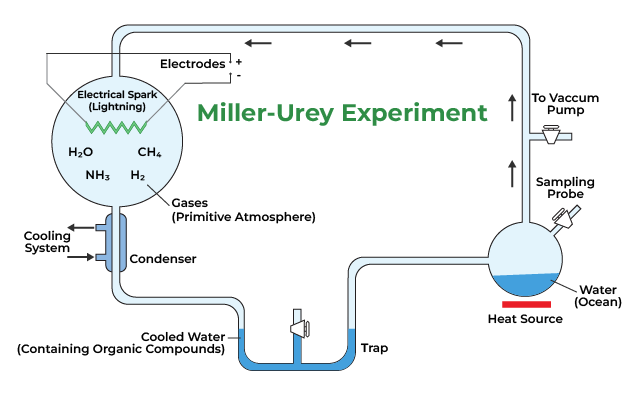Background:
Different scientists and philosophers have put forwards different explanation of origin of life on earth from time to time. Some of the most popular hypotheses about the origin of life include the following:
- Theory of Special Creation
- Interplanetary theory
- Catastrophic theory
- Theory of Spontaneous generation or Abiogenesis theory
- Biogenesis theory
- Panspermia Theory or Cosmozoic theory
- Modern theory of origin of life or Oparin-Haldane theory of origin of life
Introduction:
- It is a modern theory of origin of life that was proposed by Russian scientist Aleksandr Oparin (1924) and J. B. S. Haldane, an England born Indian scientist (1929), independently proposed that life is originated by the composition of chemicals. This theory was published in book ‘Origin of Life’.
- This theory was first widely accepted scientific theory of organic evolution of life. According to this theory life is originated in warm water of primitive ocean by interaction between simple organic compound.
- They proposed new theories for the origin of life which is later refer as the Oparin-Haldane hypothesis that state that early life could have come from pre existing non living organic matter molecules through the process of abiogenesis.
- Oparin theory is based on artificial synthesis which is also called as artificial synthetic theory.
- The Oparin-Haldane hypothesis proposes that life evolved gradually from inorganic molecules, with “building blocks” like amino acids forming first and later combining to form complex polymers.
Stages:
This theory possesses three stages:
Chemogeny
- Formation of simple organic compound
- Temperature started cooling down followed by heavy rain that leads to the formation of primitive ocean.
- Formation of broth (water, minerals, and gases such as methane, ammonia, and hydrogen).
- Sun (UV rays), volcanic eruption and lightening were the energy sources.
- Interaction of gases (methane, ammonia, and hydrogen) with in warm water of primitive ocean results in the formation of simple organic compounds like aldehyde ketone, alcohol, and ethylene.
- Moreover, interaction of simple organic compounds results in the formation of simple sugars and amino acids also know as formation of first biomolecules.
- Subsequently, the polymerisation of simple organics compounds results in the formation of polysaccharides, protein and fatty acid. Furthermore, the more interaction results in formation of lipids, purines, pyrimidines, nucleoside, nucleotide.
Biogeny
- Formation of self-replicating molecules
- Nucleotide which is formed in the Chemogeny phases after interaction result sin the formation of RNA. RNA acts a genetic material and enzymes. Subsequently, the DNA was formed from RNA and also RNA also interacts with protein to form nucleoprotein to form virus. Virus is the first non-cellular form of life which is also known as eobiont.
- Likewise, DNA also react with nucleoprotein to form prokaryotes anaerobic chemoheterotrophs which represent first cell.
- These stages explain the formation of first life and how it was evolved.
Cognogeny
- Prokaryotes anaerobic chemoheterotrophs represent first cell used energy released form the fermentation of organic compound.
- Due to large number of prokaryotes anaerobic chemoheterotrophs, their exist a competition and mutation form mutation result in the formation of prokaryotes anaerobic autotrophs. They prepared their own food from inorganic matters.
- Furthermore, anoxygenic photosynthetic bacteria such as sulphur bacteria were formed that will use sunlight using bacteriochlorophyll which was developed in the bacteria.
- Oxygenic photosynthetic bacteria were developed that contain chlorophyll a and chlorophyll b that use carbon dioxide and water in presence of sunlight to form glucose and oxygen will released. The release of oxygen results in the development to cyanobacteria also known as Blue Green Algae (BGA) around 3.5 billion years ago.
- More evolution and interaction result in the first unicellular eukaryotes around 1.5 billion years ago. Further evolution results in multicellular eukaryotes.
Oxygen revolution:
Early atmosphere transform from reducing to oxidising and the free molecular oxygen will react with gases like methane or ammonia to form carbon dioxide, nitrogen, etc. Formation of ozone layer results and will absorb UV ray from sun.
Miller and Urey’s Experiment:
- In 1953, an American chemist Stanley Miller at university of Chicago under the supervision of Harold C. Urey created similar conditions in laboratory and conducted an experiment to test and prove chemosynthetic theory or Oparin and Haldane theory. They reported the production of biomolecules from simple gaseous starting materials.
- It is also known as simulating experiment or spark discharge apparatus
- They built a closed system containing a heated pool of water around 5 litres and a mixture of gases that were thought to be abundant in the atmosphere of early earth CH4, NH4, H2 in the ration of 2:1:2.
- To simulate the lightning that might have provided energy for chemical reactions and interaction in the early atmosphere in earth, Miller and Urey introduced an electricity of around 75,0000 volt that will generate spark water vapour at 800 degrees Celsius.
- He observed the formation of amino acids such glycine, alanine, glutamate and aspartate. In similar experiments other scientist observed formation of sugar, nitrogen bases, pigment, and fats.

Source: https://www.geeksforgeeks.org/
- This experiment was widely accepted with the conclusion that organic compounds such as amino acids, sugars can be synthesized from simple inorganic molecules under prebiotic conditions. Equally, it supports the theory of abiogenesis supporting chemical evolution.
- The experiment was designed to mimic the primordial conditions of earth. A boiling water containing water to stimulate the primordial ocean, a mixture of gases that resemble the atmosphere and a condenser that looks like a water cycle.
- Water was heated to generate water vapor, an electric discharge to generate spark and stimulate lighting energy input.
- After the reaction, the collected liquid was further analyzed and confirmed that it contains amino acids, hydrocarbons, which are the primary components of complex biomolecules which validate the hypothesis that organic molecules could form spontaneously under prebiotic conditions.
